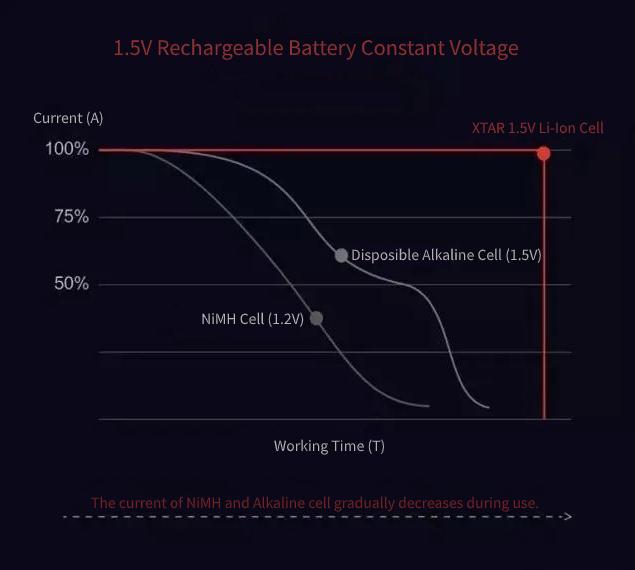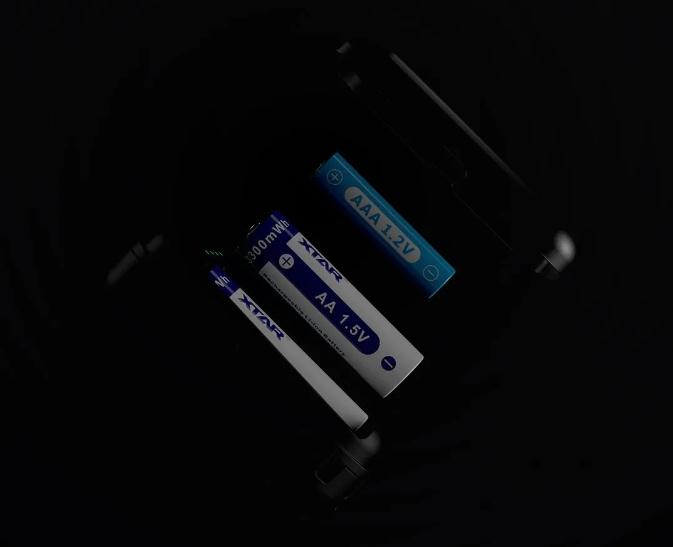Address
5th Floor, No.77 Xinhe Rd, Shangmugu, Pinghu Area, Longgang District, Shenzhen, Guangdong, China
Contact
Email [email protected]
Tell (+86) 755-25507076
5th Floor, No.77 Xinhe Rd, Shangmugu, Pinghu Area, Longgang District, Shenzhen, Guangdong, China
Email [email protected]
Tell (+86) 755-25507076
Traditional AA/AAA rechargeable batteries have always been the world of NiMH batteries, especially the appearance of Eneloop. However, although NiMH rechargeable batteries are comparable to lithium-ion batteries in terms of cycle times and memory effects, the standard voltage of 1.2V cannot play strength on some devices with higher voltage requirements, and only disposable alkaline batteries can be selected. In recent years, a new battery – 1.5V rechargeable lithium ion battery has appeared on the market.
Its principle is a 3.6/3.7V lithium battery be stepped down to a 1.5V constant voltage output through a built-in circuit module. So, how do these new 1.5V batteries perform compared to NiMH batteries and disposable alkaline batteries? Let’s take a look.
Advantages
Constant Voltage, Stable Performance
In contrast, the output of the 1.5V rechargeable lithium battery is a constant voltage of 1.5V, and its discharge voltage can be simply understood as a horizontal straight line. In this straight line, due to the constant voltage, the devices such as racing cars, remote controls, electric toys, etc. that use this battery will also maintain stable performance. But the discharge current of the 1.2V rechargeable battery and disposible alkaline battery will gradually decreases during use, just as the following picture shows.

Long Battery Life
Compared with NiMH batteries, lithium batteries have no memory effect, which is a great breakthrough. If the traditional nickel-metal hydride battery is not deeply discharged for a long time, the battery capacity will become smaller and smaller, and the battery life will also be greatly reduced. There is no such concern in using lithium batteries. You can charge and discharge your lithium battery at any time. Small amount of charge and discharge can even reduce the loss of the battery.
On the other hand, although many manufacturers promise that their NiMH batteries can be used 500 times, due to the memory effect, you need to charge and discharge the battery from time to time to release the capacity of the battery. This will inevitably shorten the battery life. In contrast, the life of the 1.5V rechargeable lithium battery depends on battery cells. For example, XTAR’s upcoming 1.5V AA rechargebale lithium battery uses internationally renowned battery cells, and there is still ≥80% capacity remaining after 500 times of use.

Has All Advantages of Lithium Batteries
Since the 1.5V rechargeable lithium battery is reduced voltage from the 3.6/3.7 lithium battery, it has all the advantages of Lithium batteries, such as fast charging speed, low self-discharge rate, high safety and performance, large discharge current, excellent high and low temperature discharge performance and so on.
Eco-Friendly and Save Money
Disposable batteries are terribly harmful to the environment, and through it to our health, since these toxic substances are not removed from the human body. Mercury, lead, cadmium, nickel, zinc, alkalis … quietly and quietly take health and life.
It can be used for 500 to 1000 times, and the power of full charge is equivalent to that of 2 to 5 disposible alkaline batteries. That means one lithium battery is equivalent to 1000 to 1500 alkaline batteries. The cost per use is less than 4 cents, which is truly economical and environmentally friendly.
Lithium batteries last longer, save money and therefore do less harm. Just remember to return the batteries for recycling.
Disadvantages
AA rechargeable lithium battery is suitable for a wide range of applicable scenarios. It can do almost all the work that NiMH batteries can do, such as wireless mouse and keyboard, electric toys, etc., and the average voltage output is higher than NiMH batteries. However, it also has two disadvantages.
On one hand, in high-current use scenarios, such as camera speedlights, it is possible that this type of lithium battery can not be used, or the use effect is poor (slow recycling speed), because the current required for camera flash recycling is very large.
On the other hand, because the 1.5V rechargeable battery has constant voltage, the capacity is uncontrollable. Before your devices run out of power, you don’t know how much power it has. Your devices can’t judge the capacity by measuring the voltage.
The Ideal Devices & Battery Cost
After learning the advantages and disadvantages of the rechargeable AA and AAA lithium batteries, you may already know what devices are these batteries most suitable. Yes, they are ideal for the medium or high drain devices.
Many people heared of this battery but they are prevented to have a try by the price. Why are AA lithium batteries so expensive? This battery remains the features of the lithium cell, and has a built-in 3-in-1 smart chip for safe charging/discharging/using so that it brings higher performance than Alkaline and NiMH batteries. This is what other AA and AAA batteries don’t have. Actually, it provides potential long-term savings and environmental benefits. You can read more details here.
Summary
The 1.5V rechargeable lithium battery has its unique advantages – the voltage output is higher than that of nickel-metal hydride and nickel-cadmium batteries, and there will be no voltage drop during discharge. It is very powerful in driving small current devices like wireless mouses, Xbox controllers, game handles, electric toys, electric toothbrushes and so on. And the charging speed is fast, and it can be fully charged in 1-2 hours.
Moreover, as the technology matures, the cost factors that mainly limit the development of 1.5V rechargeable lithium batteries will gradually weaken. Its advantages will gradually become more prominent, and more supporting products will also be available.